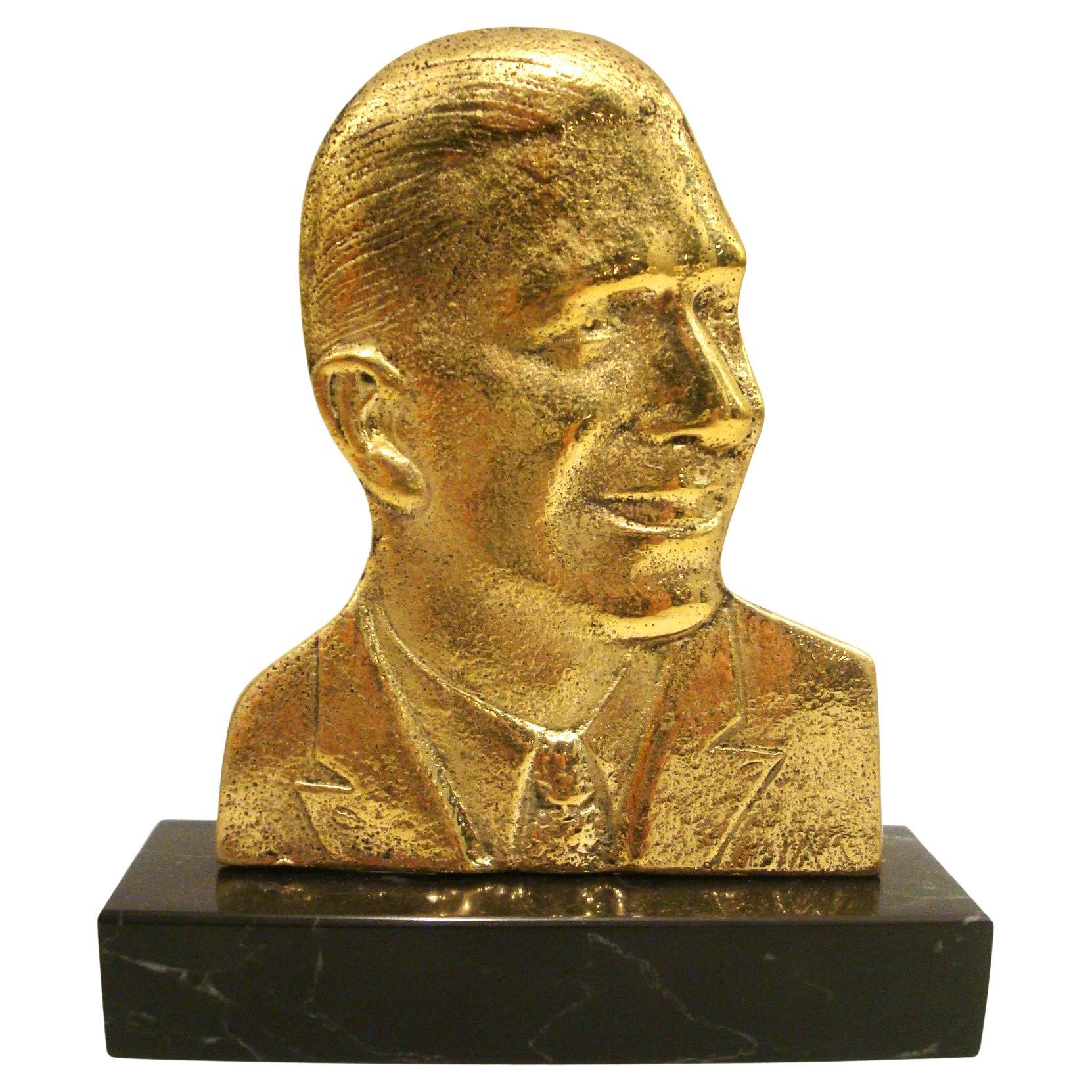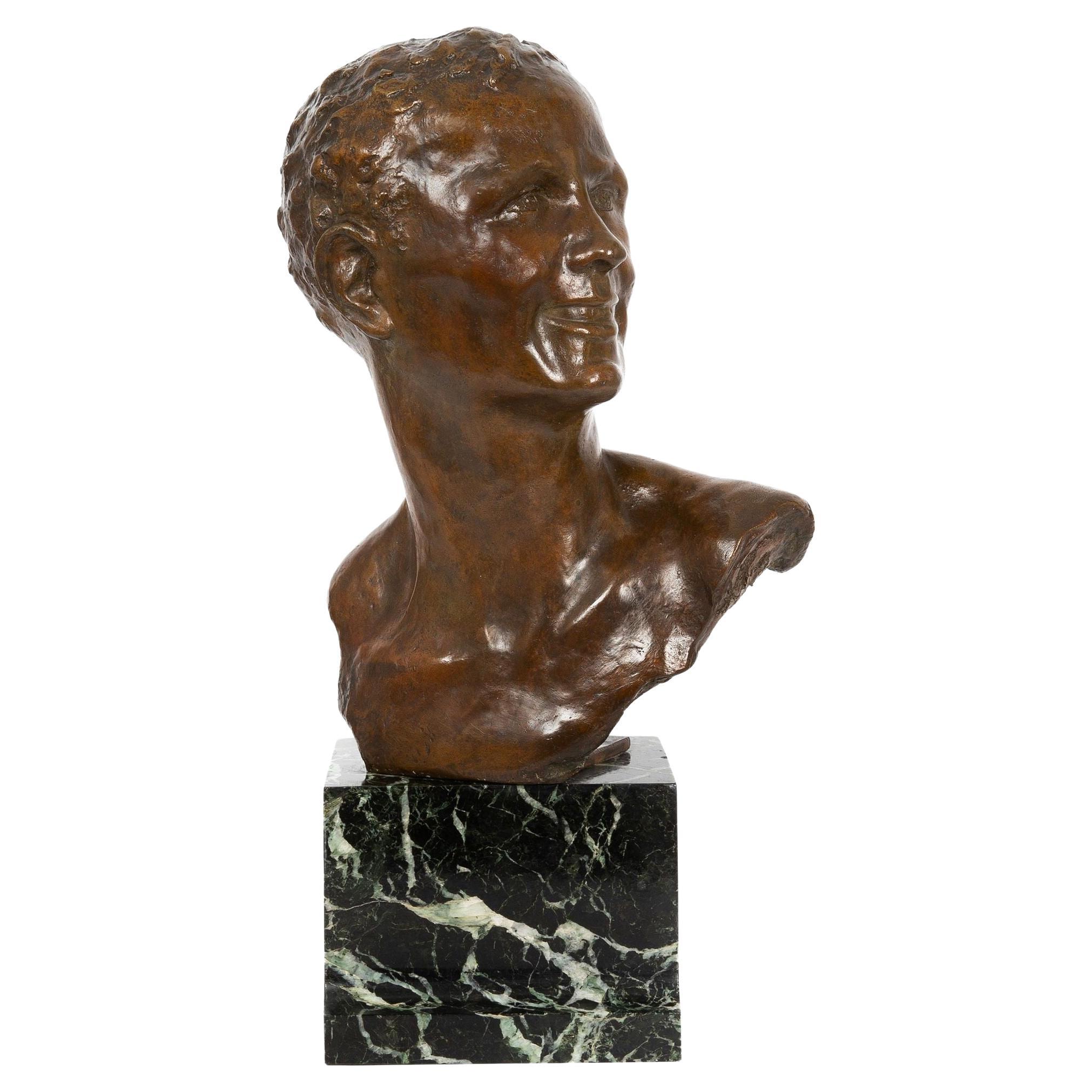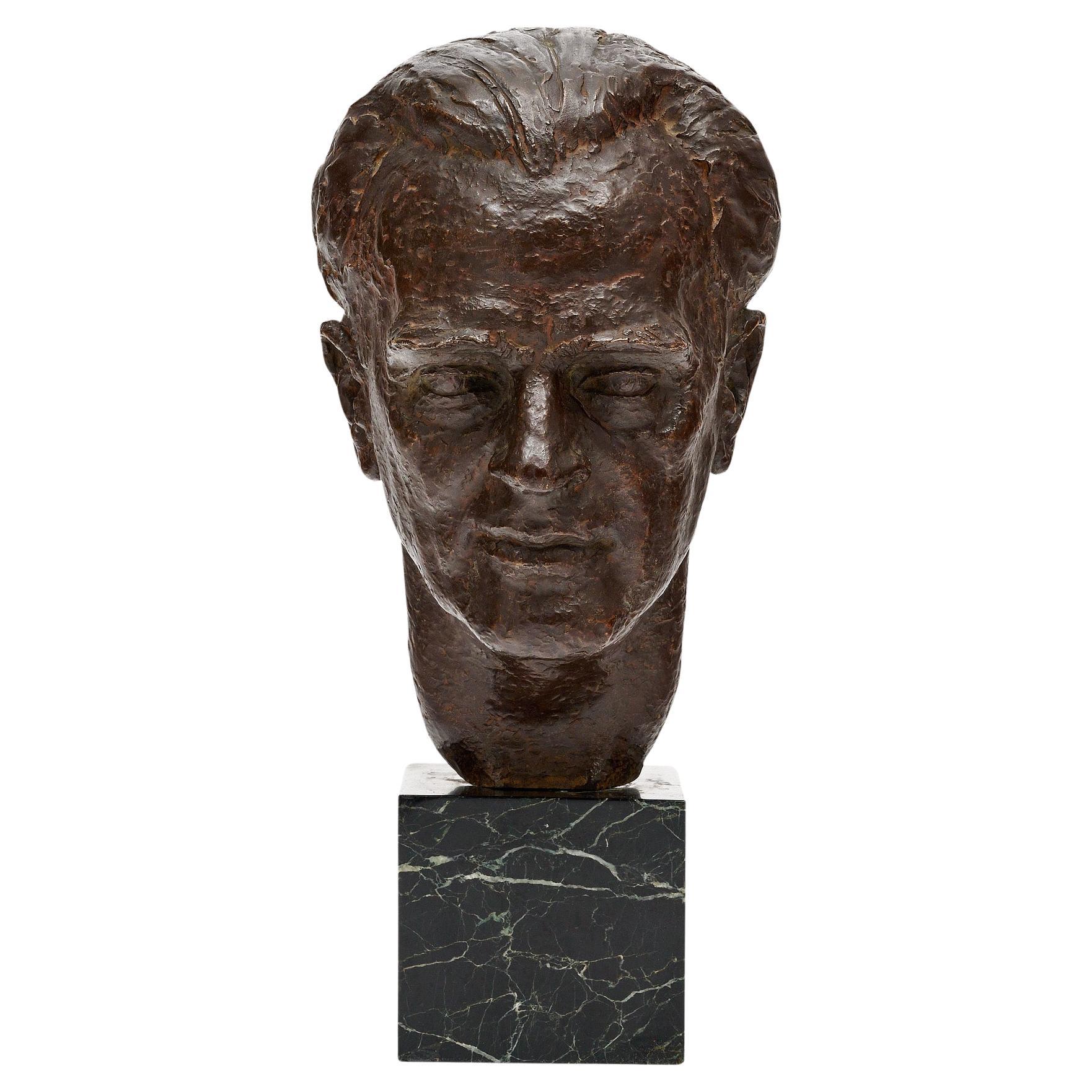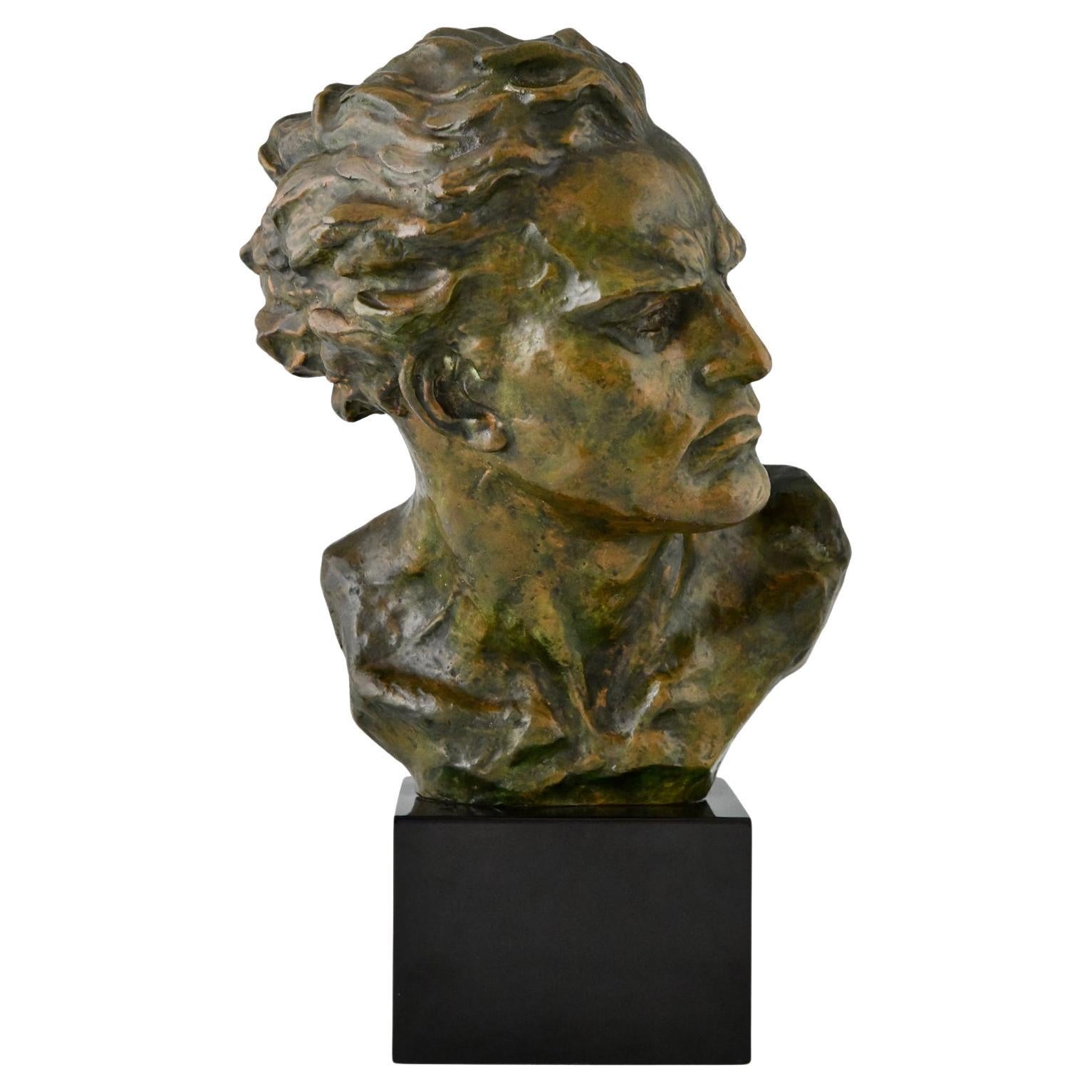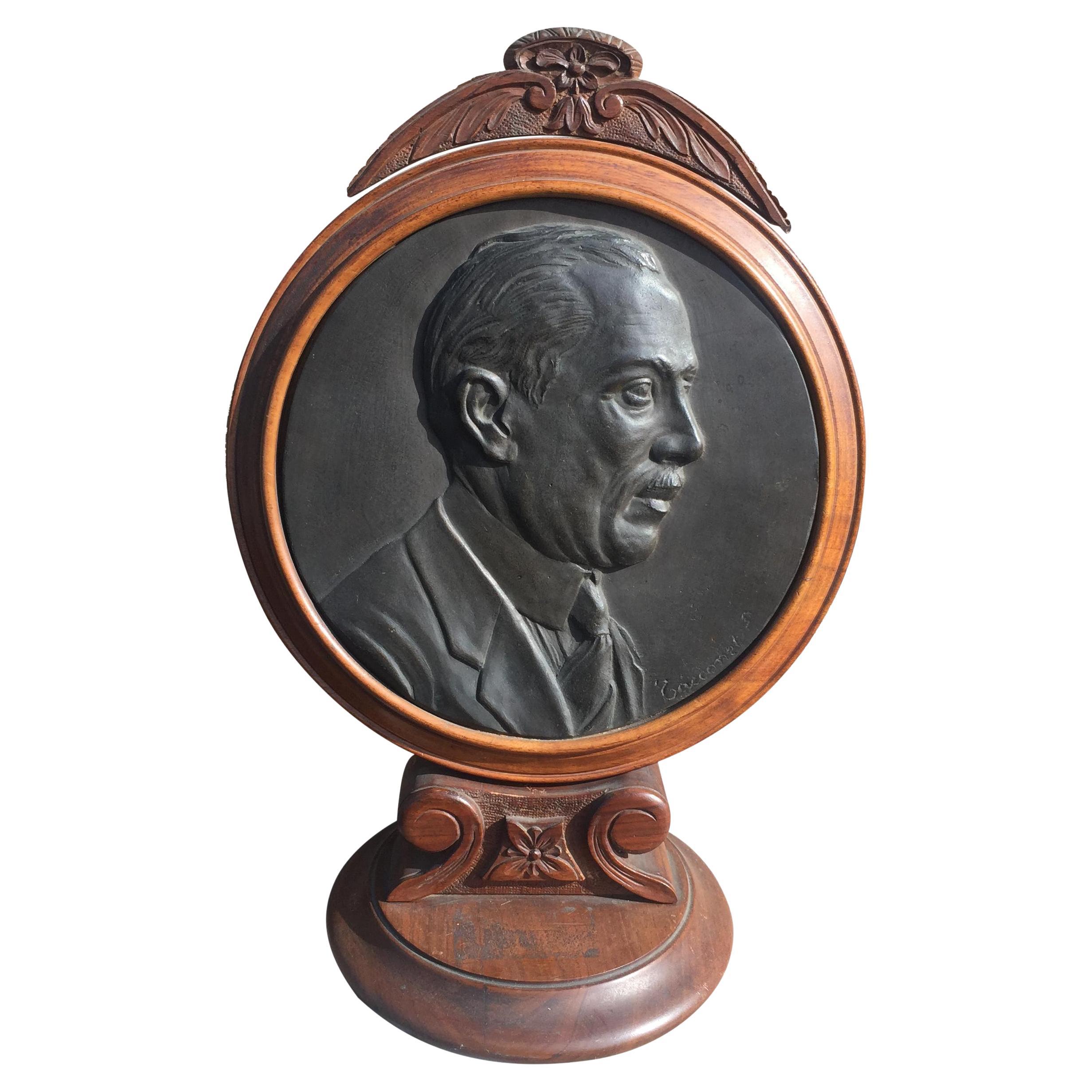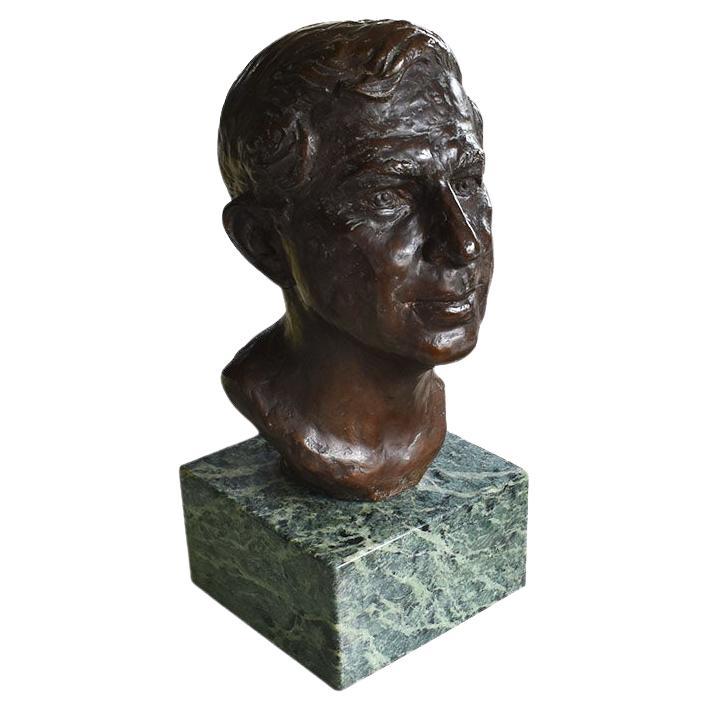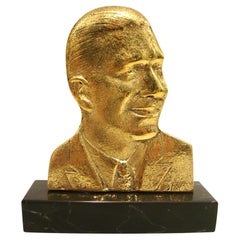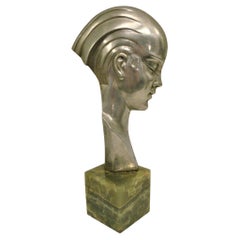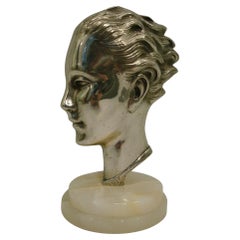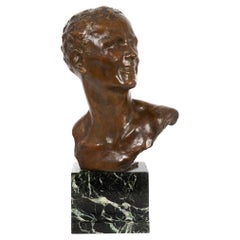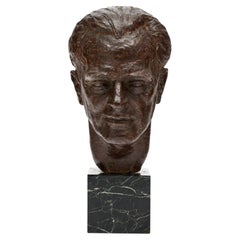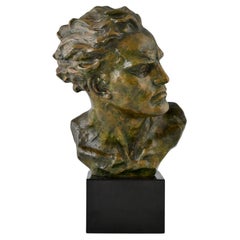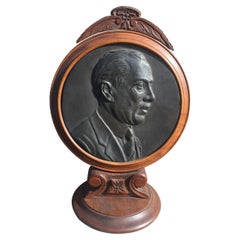Items Similar to Carlos Gardel Tango Bronze & Marble Plaque Portrait / Sculpture
Want more images or videos?
Request additional images or videos from the seller
1 of 9
Carlos Gardel Tango Bronze & Marble Plaque Portrait / Sculpture
$1,530
£1,153.77
€1,334.39
CA$2,146.58
A$2,386.06
CHF 1,250.72
MX$29,139.55
NOK 15,614.53
SEK 14,690.36
DKK 9,959.52
About the Item
Carlos Gardel Tango Bronze & Marble Plaque Portrait / Sculpture.
The signature is Hard to understand.
Carlos Gardel (born Charles Romuald Gardès; 11 December 1890 – 24 June 1935) was a French-born Argentine singer, songwriter, composer and actor, and the most prominent figure in the history of tango. He was one of the most influential interpreters of world popular music in the first half of the 20th century. Gardel is the most famous popular tango singer of all time and is recognized throughout the world. Described variously as a baritone or tenor because of his wide vocal range, he was known for his rich voice and dramatic phrasing. Together with lyricist and long-time collaborator Alfredo Le Pera, Gardel wrote several classic tangos.
Gardel died in an airplane crash at the height of his career, becoming an archetypal tragic hero mourned throughout Latin America. For many, Gardel embodies the soul of the tango style. He is commonly referred to as "Carlitos", "El Zorzal" ("The Song thrush"), "The King of Tango", "El Mago" (The Wizard), "El Morocho del Abasto" (The Brunette boy from Abasto), and ironically "El Mudo" (The Mute).
We have specialized in the sale of Art Deco and Art Nouveau and Vintage styles since 1995. If you have any questions we are at your disposal. Pushing the button that reads 'View All From Seller'. And you can see more objects to the style for sale. Why are there so many antiques in Argentina?
In the 1880 – 1940 there was a grate wave of immigration encouraged by the periods of war that were taking place. 1st World War took place between 1914 and 1918 2nd World War took place between 1939 and 1945 The immigrants options were New York or Buenos Aires. Tickets were cheap and in Buenos Aires they were welcomed with open arms, as it was a country where everything was still to be done. Argentina was the country of new opportunities, labour was needed and religious freedom was assured, in many cases the of the family travel first until they were settled and then the rest of the family members join them. In the immigrant museum “Ellis Island Immigrant Building” in New York you can se the promotional posters of the boats that would take them to a new life. Between the years 1895 and 1896, Argentina had the highest DGP (gross domestic product) per capita in the world according to the Maddison Historical Statistics index, this situation arose due to the large amount of food being exported to European countries, which were at war. The Argentinean ships left the port of Buenos Aires with food, but they returned with furniture, clothes and construction elements, (it´s common to see this the old buildings of the historic neighbourhood of San Telmo, the beams with the inscription “Made in England)”, as well as many markets that were built in Buenos Aires, such us the San Telmo Market, whose structure was brought by ship and afterwards assembled in 900 Defensa Street. With the great influence of European immigrants living in the country, the children of the upper classes travelled to study in France, resulting in the inauguration of “La Maison Argentinienne”, on 27th of June 1928, in the international city of Paris, which hosted many Argentinians that were studying in Frace. It´s the fourth house to be built after France, Canada and Belgium, being the first Spanish-speaking one. Still in place today (17 Bd Jourdan, 75014, Paris, France). Many of the children of these wealthy families who attended international art exhibitions, museums and art courses abroad, took a keen interest in the European style. This is why Buenos Aires was at the time referred as “The Paris of South America”. Between the years 1890 and 1920 more than a hundred Palaces were built on Alvear Avenue the most exclusive avenue in Buenos Aires. Today some of these palaces have been transformed into museums, hotels and embassies. In the year 1936, the Kavanagh building was inaugurated, it was the tallest reinforced concrete building in South America. During 1994 the American Society of Civil Engineers distinguished it as an “international engineering milestone”, and it´s now considered a World Heritage of Modern Architecture. At the time was common to hire foreign architects such as Le Corbusier, who visited Buenos Aires/Argentina in 1929 and in 1948 he drew up the blueprints for a house built in La Plata City (which was declared a World Heritage Site). In 1947, the Hungarian architect Marcelo Breuer designed “Parador Ariston” in the seaside city of Mar del Plata. After an Argentinean student at Harvard University convinced him to come to Argentina. He worked on an urban development project in the Casa Amarilla, area of La Boca. The Ukrainian architect, Vladimiro Acosta, arrives in Argentina in 1928 and worked as an architect until que moved to Brazil. Antonio Bonet, a Spanish architect who worked with Le Corbusier in Paris, arrives in Argentina in 1937, where he carried out several architectural works and in 1938 designs the well-known BFK chair. Andres Kálnay, of Hungarian origin, made around 120 architectural masterpieces, among which the former Munich brewery stands out, he even made the furniture’s design. The German architect, Walter Gropius, director of the Bauhaus, lived in Argentina, where he wrote articles for “Sur” magazine and founded in Buenos Aires, an architectural firm with Franz Möller, who was also an architect, where he built two houses. At the same time several famous designers decided to immigrate to Argentina, among them we can find the well-known French designer, Jean-Michel Frank, who arrived in the country in 1940 and also worked for the Rockefeller family. Special pieces were made, which were sold exclusively in the country, such as the well-known German company “WMF”, who sold their products by catalogue, which were chosen by the ladies of high society in the list of wedding gifts, as well as the pieces designed by Christofle. The Swiss sculptor Alberto Giacometti, made special pieces for Argentinean mansions. In 1904 the first Jansen branch outside Paris was established in Buenos Aires, as the Argentinean clientele demanded a large amount of furniture, from the end of the 19th century to the mid-20th century. In 1970, the brand Rigolleau Argentina made pieces authorised by Lalique. The brands Maple and Thompson also set up shop in the country. The French plastic artist, Marcel Duchamp moved to Argentina in 1918-1919. Glass signed Gallé, Charder, Leverre, Schneider, Muller and other French firms. They were bought in flower shops and were given to ladies with beautiful floral arrangements. Some furniture manufacturers travelled to international fairs and bough the patterns to produce the furniture in Argentina, such as the furniture firm Englander and Bonta, who bought the patterns in Italy. It is worth mentioning that in Argentina we have the largest community of Italians outside of Italy, as it is estimated that 70 percent of the inhabitants have at least one Italian descendant, followed by Spanish immigrants. The most Important furniture stores in Argentina: Comte is founded in 1934 (under the direct management of Jean Michel Frank in 1940). Nordiska (Swedish company established in 1934). Churba in 1960, a company that brought foreign designers to present their furniture in the country: Denmark: (Arne Jacobsen, Finn Juhl, Bender Madsen, Ejner Larsen, Poul Kjaerholm, Hans Wegner) Sweden: (Hans Agne Jakobsson, Gustavsberg) United States: (Herman Miller) Finland: (Lisa Johansson, Folke Arstrom, Tapio Wirkkala, Alvar Aalto, Timo Sarpaneva) Swedish Factory: (Orrefors) Italy: (Littala, Vico Magistretti, Emma Gismondi, Gae Aulenti, Angelo Mangiarotti, Elio Martinelli, Gianna Celada, Angelo Mangiarotti, Mario Bellini, Carlo Scarpa) Finland: (Olivia Toikka) Plata Lappas (Lappas Silver): a goldsmith shop founded in 1887 in Argentina by Alcibiades Lappas of Greek origin. In 2019, in Argentina took place “the Art Deco world congress” . Argentina currently has more than 100 Art Deco buildings and another 90 Art Nouveau buildings throughout the city of Buenos Aires. Argentina is a country that has not been involved in many wars, which is why it has been a refuge for works of art and antiques from different periods of time, unlike European countries. That is way many collectors, museums and antique dealers from all over the world visit it, you should not miss the opportunity to visit this great country.
- Dimensions:Height: 7.88 in (20 cm)Width: 7.09 in (18 cm)Depth: 1.97 in (5 cm)
- Style:Mid-Century Modern (Of the Period)
- Materials and Techniques:
- Place of Origin:
- Period:
- Date of Manufacture:1930´s
- Condition:Wear consistent with age and use.
- Seller Location:Buenos Aires, AR
- Reference Number:1stDibs: LU2027343238062
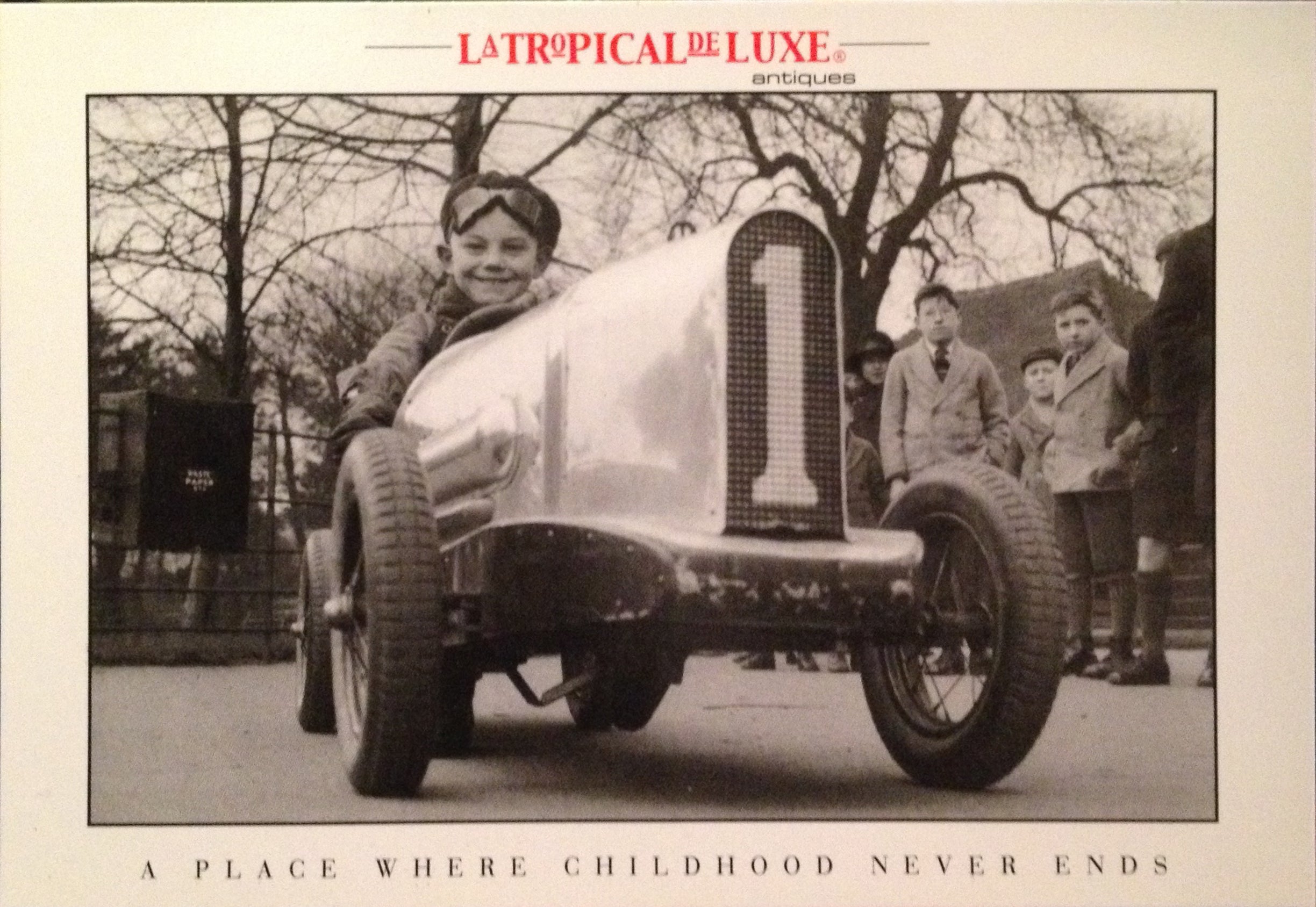
About the Seller
4.9
Vetted Professional Seller
Every seller passes strict standards for authenticity and reliability
Established in 2002
1stDibs seller since 2016
322 sales on 1stDibs
Typical response time: 1 hour
- ShippingRetrieving quote...Shipping from: Buenos Aires, Argentina
- Return Policy
Authenticity Guarantee
In the unlikely event there’s an issue with an item’s authenticity, contact us within 1 year for a full refund. DetailsMoney-Back Guarantee
If your item is not as described, is damaged in transit, or does not arrive, contact us within 7 days for a full refund. Details24-Hour Cancellation
You have a 24-hour grace period in which to reconsider your purchase, with no questions asked.Vetted Professional Sellers
Our world-class sellers must adhere to strict standards for service and quality, maintaining the integrity of our listings.Price-Match Guarantee
If you find that a seller listed the same item for a lower price elsewhere, we’ll match it.Trusted Global Delivery
Our best-in-class carrier network provides specialized shipping options worldwide, including custom delivery.More From This Seller
View AllCarlos Gardel Tango Bronze & Marble Plaque Desk Portrait / Sculpture 1950´s
Located in Buenos Aires, Olivos
Carlos Gardel Tango Polished Bronze & Marble Plaque Desk Portrait / Sculpture.
Carlos Gardel (born Charles Romuald Gardès; 11 December 1890 – 24 June 19...
Category
Mid-20th Century Argentine Mid-Century Modern Busts
Materials
Belgian Black Marble, Bronze
Art Deco Bronze Sculpture Bust Woman Profile Guido Cacciapuoti 1930
By Guido Cacciapuoti
Located in Buenos Aires, Olivos
Stylish Art Deco bronze bust of a woman in profile.
Attributed to Guido Cacciapuoti.
The bronze has a silver patina and stands on a green marble base.
Italy 1930-1940.
We have speci...
Category
Mid-20th Century Italian Art Deco Figurative Sculptures
Materials
Marble, Bronze
Art Deco Bronze Bust Sculpture of a Woman / France, 1930
By Auscher
Located in Buenos Aires, Olivos
Art Deco bust of a woman. Silvered bronze sculpture of a moderniste lady.
Mounted over a Italian marble base. Signed on the base Auscher. France 1930
Perfect desk piece or paperweigh...
Category
Early 20th Century French Art Deco Figurative Sculptures
Materials
Marble, Bronze
Art Deco / Mid-century Silvered Bronze Bust Sculpture - France 1930´s
Located in Buenos Aires, Olivos
Art Deco / Midcentury Silvered Bronze Bust - France 1930´s.
Silvered Bronze Head mounted over Onyx Marble.
Very nice Sculpture, perfect for a desk or a side table.
We have speciali...
Category
Mid-20th Century French Art Deco Busts
Materials
Onyx, Bronze
Art Deco Silvered Bronze Head / Bust Sculpture of a Woman / France, 1930
Located in Buenos Aires, Olivos
Art Deco bust of a woman. Silvered bronze sculpture of a lady.
Mounted over a Italian marble base. France 1930's.
Perfect desk piece or paperweight.
We have specialized in the sale ...
Category
Early 20th Century French Art Deco Figurative Sculptures
Materials
Marble, Bronze
Art Deco Silvered Bronze Bust Sculpture of a Woman / France, 1930
Located in Buenos Aires, Olivos
Art Deco Silvered Bronze Bust Sculpture of a Woman / France, 1930
Art deco silvered bronze sculpture of a stylized human head, mounted on a black oval marble base. The head is tilted...
Category
Mid-20th Century French Art Deco Figurative Sculptures
Materials
Marble, Bronze
You May Also Like
French Art Deco Modernist Bronze Sculpture, Bust of Young Man, Alfredo Pina
By Alfredo Pina
Located in Shippensburg, PA
ALFREDO PINA
French, 1883-1966
Bust of a Young Man
Lost-wax cast medium-brown patinated bronze over solid verde marble plinth signed in cast "A. Pina" and sealed with cachet "cire...
Category
20th Century French Art Deco Busts
Materials
Marble, Bronze
Art Deco Period French Bronze Bust
Located in Austin, TX
Vintage bust from France made of bronze and supported by a marble base. This piece features the likeness of a man. It showcases the smelter’s stamp. This piece is in very nice vintag...
Category
Vintage 1940s French Art Deco Busts
Materials
Marble, Bronze
Art Deco Bronze Sculpture Male Bust Ugo Cipriani on marnel base France 1930
By Cipriani
Located in Antwerp, BE
Art Deco bronze sculpture male bust by Ugo Cipriani.
Patinated bronze.
Belgian black marble base.
France 1930.
Literatuur:
“Art Deco sculpture” Alastair Duncan.
Category
Mid-20th Century French Art Deco Busts
Materials
Belgian Black Marble, Bronze
20th Century Round Bronze Plaque Depicting a Male Profile on Wooden Stand
Located in Catania, Sicilia
Round Bronze Plaque Depicting A Male Profile On A Wooden Support From The 1900s. Particular and signed object. Not easy to find, as it was commissioned by...
Category
Early 20th Century Italian Art Nouveau Figurative Sculptures
Materials
Bronze
Bronze Bust Sculpture Att. Will Rogers on Green Stone Base by Leonard McMurry
Located in Oklahoma City, OK
A large striking bronze bust sculpture of a man with the likeness of Will Rogers. This piece was created by Leonard McMurry, also known as Oklahoma’s “Michelangelo”. It stands on a green marbled stone square base.
The sculpture depicts a man, with an extreme likeness to Will Rogers. The man has combed hair, which is parted to one side. The sculpted bronze bust has a fabulous patina, and the square green stone it is affixed to is marbled with fantastic greens, blacks, and creams.
About the Artist:
Leonard McMurry, (1913–2008) - McMurry is best known for his bronzes, which are primarily figurative, in many venues, from Oklahoma City to St. Louis to New York City. In 1941 his work received Honorable Mention in the Prix de Rome competition. In 1952 his work was included in the National Sculpture Society show in New York. Among his works in Oklahoma are The 89er, at the Oklahoma City Civic Center, The Legend of the Great Westerner (informally called "Buffalo Bill") at the National Cowboy and Western Heritage Museum in Oklahoma City, and Healing Hands, at the City of Faith Hospital/Oral Roberts University in Tulsa. (which at the time was the largest casting in the world.) For the 1982 Diamond Jubilee of Oklahoma statehood, McMurry completed a series of twenty-one busts of Oklahoma's governors. He also created fourteen busts for the National Hall of Fame for American Indians in Anadarko. Leonard McMurry died in 2008.
Born to a family of prominent cotton farmers in the Texas panhandle, McMurry moved to Oklahoma in 1955 and studied under the sculptor's Carl Mose and Ivan Mestrovic...
Category
20th Century American Mid-Century Modern Busts
Materials
Stone, Bronze
$4,000 Sale Price
75% Off
Patinated Bronze Art Deco Figural Sculpture, Signed by Bruno Zach
By Bruno Zach
Located in London, GB
Patinated bronze Art Deco figural sculpture, signed by Bruno Zach
Austrian, Early 20th Century
Height 35cm, width 15cm, depth 10cm
This...
Category
Early 20th Century Austrian Art Deco Figurative Sculptures
Materials
Bronze
$8,277 Sale Price
20% Off
More Ways To Browse
Buenos Aires Mid Century
Argentina Poster
Belgium Travel Poster
Antique Chair Belgium
Sellers Belgium
Comte Argentina
Maison Jansen Argentina
Mid Century Danish Directors Chairs
Argentina Travel Poster
Nordiska Argentina
Marble Sculpture Antique
Sculpture Plaques
Vintage Country Living Magazines
Vintage Miller High Life
Hungarian Vintage Poster
International Vintage Poster Fair
Argentina Vintage Poster
Vintage Brazilian Posters
